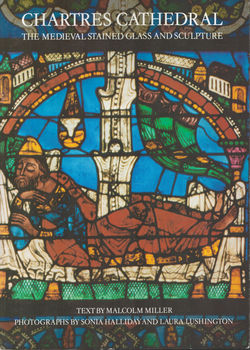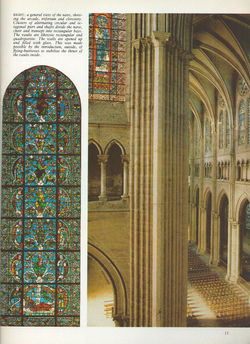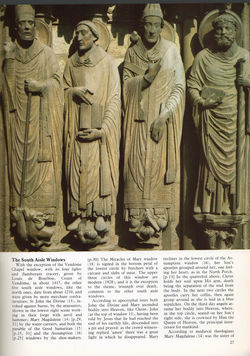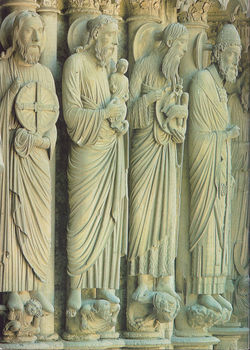CHARTRES
CATHEDRAL MEDIEVAL STAINED GLASS WINDOWS & SCULPTURE THE BLUE VIRGIN
SOFTBOUND BOOK in ENGLISH by
MALCOLM MILLER
THE TREE OF JESSE
JEREMIAH
SIMEON WITH THE CHRIST CHILD
JOHN THE BAPTIST
PETER WITH KEYS
AGNUS DEI
KING SAUL
THE ROYAL PORTAL
LIFE OF CHRIST WINDOW
ST FULBERT AND THE CHARTRES
CATHEDRAL SCHOOL
FULBERT’S CATHEDRAL 1020-37
THE 12TH CENTURY
GLASS
NOTRE-DAME DE LA BELLE VERRIERE
(THE BLUE VIRGIN WINDOW)
THE DEATH, ASSUMPTION AND
CORONATION OF MARY
THE JUDGEMENT OF SOLOMON
THE GOTHIC CATHEDRAL 1194-1260
THE NORTH AND SOUTH PORCHES
THE VISITATION OF MARY
CHRIST TEACHING THE PARABLES
THE CHARLEMAGNE WINDOW
THE AMBULATORY AND APSIDAL CHAPELS
THE NORTH ROSE WINDOW AND
LANCETS
DEMONS LEADING A MISER
ABRAHAM WITH THE BLESSED
DORMITION (DEATH OF MARY)
THE NORTH AISLE WINDOWS
THE SOUTH AISLE WINDOWS
ST JAMES THE GREATER
SAINTS MARTIN, JEROME, GREGORY
AND AVITUS
THE TRANSEPT AND AMBULATORY
WINDOWS
THE MARY MAGDALENE WINDOW
THE UPPER STORY WINDOWS
THE GOOD SAMARITAN WINDOW
THE LAST JUDGEMENT WINDOW
--------------------------------
Additional Information from
Internet Encyclopedia
Chartres Cathedral, also known
as the Cathedral of Our Lady of Chartres (French: Cathédrale Notre-Dame de
Chartres), is a Catholic church in Chartres, France, about 80 km (50 miles)
southwest of Paris, and is the seat of the Bishop of Chartres. Mostly
constructed between 1194 and 1220, it stands on the site of at least five
cathedrals that have occupied the site since the Diocese of Chartres was formed
as an episcopal see in the 4th century. It is in the High Gothic and Romanesque
styles, with a Flamboyant north spire.
Long renowned as "one of
the most beautiful and historically signifcant cathedrals in all of
Europe," it was designated a World Heritage Site by UNESCO in 1979, which
called it "the high point of French Gothic art" and a
"masterpiece".
The cathedral is well-preserved
and well-restored: the majority of the original stained glass windows survive
intact, while the architecture has seen only minor changes since the early 13th
century. The building's exterior is dominated by heavy flying buttresses which
allowed the architects to increase the window size significantly, while the
west end is dominated by two contrasting spires – a 105-metre (349 ft) plain
pyramid completed around 1160 and a 113-metre (377 ft) early 16th-century
Flamboyant spire on top of an older tower. Equally notable are the three great
façades, each adorned with hundreds of sculpted figures illustrating key
theological themes and narratives.
Since at least the 12th century
the cathedral has been an important destination for travellers. It attracts
large numbers of Christian pilgrims, many of whom come to venerate its famous
relic, the Sancta Camisa, said to be the tunic worn by the Virgin Mary at
Christ's birth, as well as large numbers of secular tourists who come to admire
the cathedral's architecture and art. A venerated Black Madonna enshrined
within was crowned by Pope Pius IX on 31 May 1855.
The cathedral has three great
portals or entrances, opening into the nave from the west and into the
transepts from north and south. The portals are richly decorated with sculptures,
which rendered biblical stories and theological ideas visible for both the
educated clergy and layfolk who may not have had access to textual learning.
Each of the three portals on the west façade (made 1145–55) focuses on a
different aspect of Christ's role in the world; on the right, his earthly
Incarnation, on the left, his Ascension or his existence before his Incarnation
(the era "ante legem"), and, in the center, his Second Coming,
initiating the End of Time. The statuary of the Chartres portals is considered
among the finest existing Gothic sculpture.
One of the few parts of the
cathedral to survive the 1194 fire, the Portail royal was integrated into the
new cathedral. Opening on to the parvis (the large square in front of the
cathedral where markets were held), the two lateral doors would have been the
first entry point for most visitors to Chartres, as they remain today. The
central door is only opened for the entry of processions on major festivals, of
which the most important is the Adventus or installation of a new bishop.[30]
The harmonious appearance of the façade results in part from the relative
proportions of the central and lateral portals, whose widths are in the ratio
10:7 – one of the common medieval approximations of the square root of 2.
As well as their basic functions
of providing access to the interior, portals are the main locations for
sculpted images on the Gothic cathedral and it is on the west façade at
Chartres that this practice began to develop into a visual summa or
encyclopedia of theological knowledge. Each of the three portals focuses on a
different aspect of Christ's role in salvation history; his earthly incarnation
on the right, his Ascension or existence before the Incarnation on the left,
and his Second Coming (the Theophanic Vision) in the center.
Above the right portal, the
lintel is carved in two registers with (lower) the Annunciation, Visitation,
Nativity, Annunciation to the Shepherds and (upper) the Presentation in the
Temple. Above this the tympanum shows the Virgin and Child enthroned in the
Sedes sapientiae pose. Surrounding the tympanum, as a reminder of the glory
days of the School of Chartres, the archivolts are carved with some very
distinctive personifications of the Seven Liberal Arts as well as the classical
authors and philosophers most closely associated with them.
The left portal is more
enigmatic and art historians still argue over the correct identification. The
tympanum shows Christ standing on a cloud, apparently supported by two angels.
Some see this as a depiction of the Ascension of Christ (in which case the
figures on the lower lintel would represent the disciples witnessing the event)
while others see it as representing the Parousia, or Second Coming of Christ
(in which case the lintel figures could be either the prophets who foresaw that
event or else the 'Men of Galilee' mentioned in Acts 1:9-11). The presence of
angels in the upper lintel, descending from a cloud and apparently shouting to
those below, would seem to support the latter interpretation. The archivolts
contain the signs of the zodiac and the labours of the months – standard
references to the cyclical nature of time which appear in many Gothic portals.
The central portal is a more
conventional representation of the End of Time as described in the Book of
Revelation. In the center of the tympanum is Christ within a mandorla,
surrounded by the four symbols of the evangelists (the Tetramorph). The lintel
shows the Twelve Apostles while the archivolts show the 24 Elders of the
Apocalypse.
Although the upper parts of the
three portals are treated separately, two sculptural elements run horizontally
across the façade, uniting its different parts. Most obvious are the jamb
statues affixed to the columns flanking the doorways – tall, slender standing
figures of kings and queens from whom the Portail royal derived its name.
Although in the 18th and 19th century these figures were mistakenly identified
as the Merovingian monarchs of France (thus attracting the opprobrium of
Revolutionary iconoclasts) they almost certainly represent the kings and queens
of the Old Testament – another standard iconographical feature of Gothic
portals.
Less obvious than the jamb
statues but far more intricately carved is the frieze that stretches all across
the façade in the sculpted capitals on top of the jamb columns. Carved into
these capitals is a very lengthy narrative depicting the life of the Virgin and
the life and Passion of Christ.
One of the most distinctive
features of Chartres Cathedral is the stained glass, both for its quantity and
quality. There are 167 windows, including rose windows, round oculi, and tall,
pointed lancet windows. The architecture of the cathedral, with its innovative
combination of rib vaults and flying buttresses, permitted the construction of
much higher and thinner walls, particularly at the top clerestory level,
allowing more and larger windows. Also, Chartres contains fewer plain or
grisaille windows than later cathedrals, and more windows with densely stained
glass panels, making the interior of Chartres darker but the colour of the
light deeper and richer.
These are the oldest windows in
the cathedral. The right window, the Jesse Window, depicts the genealogy of
Christ. The middle window depicts the life of Christ, and the left window depicts
the Passion of Christ, from the Transfiguration and Last Supper to the
Resurrection.[37][38] All three of these windows were originally made around
1145 but were restored in the early 13th century and again in the 19th.
The other 12th-century window,
perhaps the most famous at Chartres, is the "Notre-Dame de la
Belle-Verrière", or "The Blue Virgin". It is found in the first
bay of the choir after the south transept. Most windows are made up of around
25 to 30 individual panels showing distinct episodes within the narrative; only
Notre-Dame de la Belle-Verrière includes a larger image made up of multiple
panels. This window is actually a composite; the upper part, showing the Virgin
and Child surrounded by adoring angels, dates from around 1180 and was probably
positioned at the center of the apse in the earlier building. The Virgin is
depicted wearing a blue robe and sitting in a frontal pose on a throne, with
the Christ Child seated on her lap raising his hand in blessing. This
composition, known as the Sedes sapientiae ("Throne of Wisdom"),
which also appears on the Portail royal, is based on the famous cult figure
kept in the crypt. The lower part of the window, showing scenes from the
infancy of Christ, dates from the main glazing campaign around 1225.
The cathedral has three large
rose windows. The western rose (c. 1215, 12 m in diameter) shows the Last
Judgment – a traditional theme for west façades. A central oculus showing
Christ as the Judge is surrounded by an inner ring of twelve paired roundels
containing angels and the Elders of the Apocalypse and an outer ring of 12
roundels showing the dead emerging from their tombs and the angels blowing
trumpets to summon them to judgment.
The north transept rose (10.5 m
diameter, c. 1235), like much of the sculpture in the north porch beneath it,
is dedicated to the Virgin.[39] The central oculus shows the Virgin and Child
and is surrounded by twelve small petal-shaped windows, four with doves (the
'Four Gifts of the Spirit'), the rest with adoring angels carrying
candlesticks. Beyond this is a ring of twelve diamond-shaped openings
containing the Old Testament Kings of Judah, another ring of smaller lozenges
containing the arms of France and Castille, and finally a ring of semicircles
containing Old Testament Prophets holding scrolls. The presence of the arms of
the French king (yellow fleurs-de-lis on a blue background) and of his mother,
Blanche of Castile (yellow castles on a red background) are taken as a sign of
royal patronage for this window. Beneath the rose itself are five tall lancet
windows (7.5 m high) showing, in the center, the Virgin as an infant held by
her mother, St Anne – the same subject as the trumeau in the portal beneath it.
Flanking this lancet are four more containing Old Testament figures. Each of
these standing figures is shown symbolically triumphing over an enemy depicted
in the base of the lancet beneath them – David over Saul, Aaron over Pharaoh,
St Anne over Synagoga, etc.
The south transept rose (10.5 m
diameter, made c.1225–30) is dedicated to Christ, who is shown in the central
oculus, right hand raised in benediction, surrounded by adoring angels. Two
outer rings of twelve circles each contain the 24 Elders of the Apocalypse,
crowned and carrying phials and musical instruments. The central lancet beneath
the rose shows the Virgin carrying the infant Christ. Either side of this are
four lancets showing the four evangelists sitting on the shoulders of four
prophets – a rare literal illustration of the theological principle that the
New Testament builds upon the Old Testament. This window was a donation of the
Mauclerc family, the Counts of Dreux-Bretagne, who are depicted with their arms
in the bases of the lancets.
Each bay of the aisles and the
choir ambulatory contains one large lancet window, most of them roughly 8.1m
high by 2.2m wide. The subjects depicted in these windows, made between 1205
and 1235, include stories from the Old and New Testament and the Lives of the
Saints as well as typological cycles and symbolic images such as the signs of
the zodiac and labours of the months. One of the most famous examples is the
Good Samaritan parable.
Several of the windows at
Chartres include images of local tradesmen or labourers in the lowest two or
three panels, often with details of their equipment and working methods.
Traditionally it was claimed that these images represented the guilds of the
donors who paid for the windows. In recent years however this view has largely
been discounted, not least because each window would have cost around as much
as a large mansion house to make – while most of the labourers depicted would
have been subsistence workers with little or no disposable income. Furthermore,
although they became powerful and wealthy organisations in the later medieval
period, none of these trade guilds had actually been founded when the glass was
being made in the early 13th century. Another possible explanation is that the
cathedral clergy wanted to emphasise the universal reach of the Church,
particularly at a time when their relationship with the local community was
often a troubled one.
Clerestory windows
Because of their greater
distance from the viewer, the windows in the clerestory generally adopt
simpler, bolder designs. Most feature the standing figure of a saint or Apostle
in the upper two-thirds, often with one or two simplified narrative scenes in
the lower part, either to help identify the figure or else to remind the viewer
of some key event in their life. Whereas the lower windows in the nave arcades
and the ambulatory consist of one simple lancet per bay, the clerestory windows
are each made up of a pair of lancets with a plate-traceried rose window above.
The nave and transept clerestory windows mainly depict saints and Old Testament
prophets. Those in the choir depict the kings of France and Castile and members
of the local nobility in the straight bays, while the windows in the apse
hemicycle show those Old Testament prophets who foresaw the virgin birth,
flanking scenes of the Annunciation, Visitation and Nativity in the axial
window.
Later windows
On the whole, Chartres' windows
have been remarkably fortunate. The medieval glass largely escaped harm during
the Huguenot iconoclasm and the religious wars of the 16th century although the
west rose sustained damage from artillery fire in 1591. The relative darkness
of the interior seems to have been a problem for some. A few windows were
replaced with much lighter grisaille glass in the 14th century to improve
illumination, particularly on the north side and several more were replaced
with clear glass in 1753 as part of the reforms to liturgical practice that
also led to the removal of the jubé (rood screen). The installation of the
Vendôme Chapel between two buttresses of the nave in the early 15th century
resulted in the loss of one more lancet window, though it did allow for the
insertion of a fine late-Gothic window with donor portraits of Louis de Bourbon
and his family witnessing the Coronation of the Virgin with assorted saints.
Although estimates vary
(depending on how one counts compound or grouped windows) approximately 152 of
the original 176 stained glass windows survive – far more than any other
medieval cathedral anywhere in the world.
Like
most medieval buildings, the windows at Chartres suffered badly from the
corrosive effects of atmospheric acids during the Industrial Revolution and
thereafter. The majority of windows were cleaned and restored by the famous
local workshop Atelier Lorin at the end of the 19th century, but they continued
to deteriorate. During World War II most of the stained glass was removed from
the cathedral and stored in the surrounding countryside to protect it from
damage. At the close of the war the windows were taken out of storage and
reinstalled. Since then, an ongoing programme of conservation has been underway
and isothermal secondary glazing was gradually installed on the exterior to
protect the windows from further damage.








